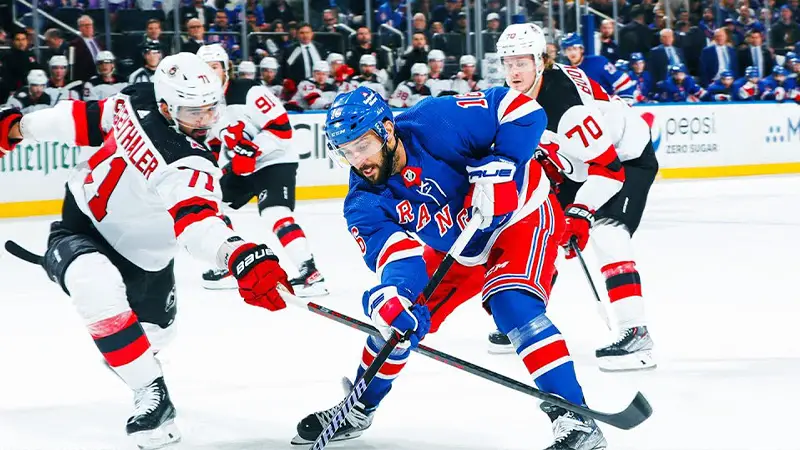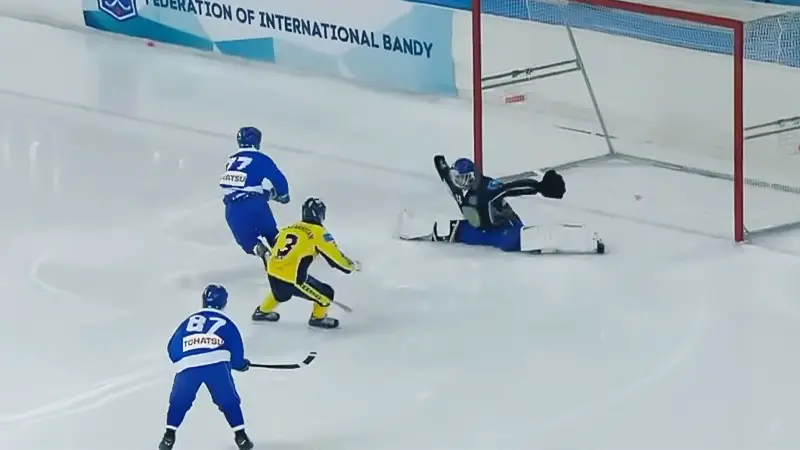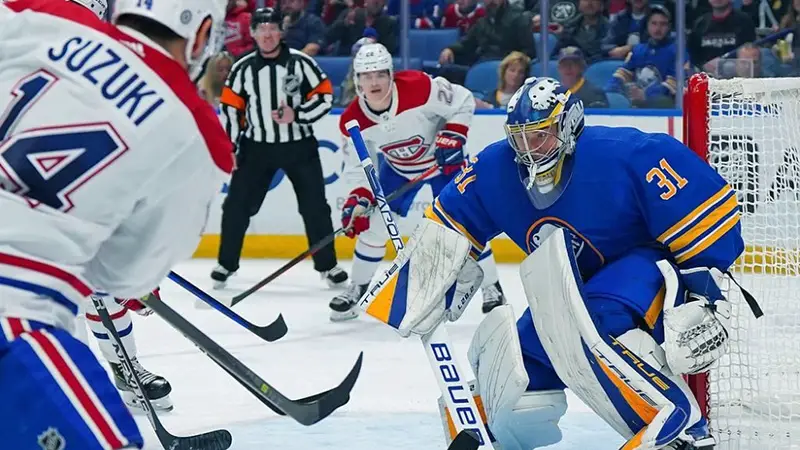NHL enthusiasts have likely encountered the frustrating message: “This game is blacked out in your area.” For die-hard fans, it’s a confounding conundrum.
In this blog post, we delve into the intricate world of NHL blackouts to unravel the reasons behind these seemingly vexing restrictions.
These blackout rules, while prevalent in various professional sports leagues, take on a unique character within the NHL, shaping the viewing experience of hockey aficionados.
From protecting local broadcast rights to stimulating attendance at live games, NHL blackouts serve a dual purpose—ensuring the financial well-being of the league and its teams while nurturing the electric atmosphere of in-person spectacles.
To understand why your favorite game might be cloaked in darkness, we explore the specifics of NHL blackout rules and their distinctive attributes.

What are NHL Blackouts?
NHL blackouts refer to restrictions placed on the broadcasting of certain NHL games in specific geographic regions. These blackouts are implemented to protect and support the local television markets of NHL teams.
Here’s how they work:
Regional Games
Each NHL team typically has a designated regional broadcaster that holds the rights to televise their games within a specific geographic area. These games are known as “regional games.”
Regional games are intended to cater to the local fan base and are often sold to a local or regional television network.
National Games
In addition to regional games, there are also “national games” that are available for broadcast nationwide.
These games are usually broadcast on national sports networks like NBC or ESPN and can be watched by viewers across the country.
Blackout Rules
When an NHL team plays a regional game, the league enforces blackout rules to protect the exclusivity of the regional broadcaster.
These rules prevent people who are located within the team’s designated broadcast region from watching the game on national television or online streaming services.
Instead, they are encouraged to watch the game on their local or regional channel.
Determining Your Location
Blackouts are enforced based on the physical location of the viewer.
If you are within the designated broadcast region of a specific NHL team, you may experience a blackout for that team’s regional games if you attempt to access the game through a national broadcast or online streaming service.
Conversely, if you are outside the team’s region, you can typically watch the game without any blackout restrictions.
The goal of these blackouts is to maintain the value of local broadcasting rights and encourage viewers to support their local teams by tuning into the regional broadcasts.
This system helps teams generate revenue through local advertising and ensures that regional broadcasters can provide comprehensive coverage of their respective teams.
Why Are NHL Games Blacked Out
NHL games are blacked out primarily for two reasons:
Protecting Local Broadcast Rights
The NHL wants to protect the financial interests of teams and their local broadcasters.
When a team enters into a contract with a local or regional broadcaster, that broadcaster often pays a significant amount of money for the exclusive rights to broadcast the team’s games within a specific geographic region.
Blackout rules are enforced to ensure that viewers within that region watch the games on the local or regional channel, thereby maximizing the value of the broadcasting rights.
Encouraging Attendance
Blackouts can also be used as a means to encourage fans to attend games in person. Teams want to fill their arenas with fans who purchase tickets, merchandise, and concessions.
By blacking out certain games in the local area, teams hope to create an incentive for fans to attend the games live rather than staying at home to watch on TV.
This can contribute to the overall fan experience and boost team revenue.
NHL blackouts are a way for the league to balance the interests of local broadcasters, teams, and fans.
They protect the revenue generated from local broadcasting contracts while also incentivizing fans to attend games and support their teams in person.
NHL Blackout Rules

Similar to other professional sports leagues in North America, the National Hockey League (NHL) implements blackout rules and regulations to protect the interests of its teams and local broadcasters.
These rules are mandated by the NHL and are designed to ensure that local broadcasters have exclusive access to certain games within their designated broadcast regions.
Here’s an overview of how NHL blackout rules work:
Designated Broadcast Regions
Each of the NHL’s 32 teams has its own designated broadcast region. Within this region, a local or regional broadcaster typically holds the exclusive rights to televise the team’s games.
The boundaries of these regions are determined by the NHL and are aimed at serving the local fan base.
Local Broadcast Rights
The NHL often sells the local broadcast rights to these games to local networks. This means that local broadcasters pay for the privilege of showing their team’s games to viewers within the designated broadcast region.
Enforcement of Blackouts
To enforce blackout restrictions, TV distributors and streaming services like ESPN+, Sportsnet NOW, and NHL.
TV must determine the geographic location of their subscribers. If a subscriber resides within the broadcast territory of a particular team, they will be subject to blackout rules for that team’s games.
This means that they will not be able to watch those games on national platforms or out-of-market packages.
Out-of-Market Access
To access games that are subject to blackouts, viewers typically have a few options.
They can either reside within the team’s broadcast territory or subscribe to a package that provides access to out-of-market games, such as Sportsnet NOW Premium or NHL Centre Ice.
These packages allow fans to watch games involving teams from outside their local region.
Game Replays
It’s worth noting that blackout rules typically apply to live game broadcasts.
After 48 hours, full-length blackout game replays may become available for replay, allowing viewers to catch up on games they were unable to watch live.
Examples of Blackout Rules: Let’s consider a couple of examples to illustrate how blackout rules work:
Canadian Example
Suppose Sportsnet NOW owns the regional rights to the Edmonton Oilers.
To avoid being blacked out from Oilers games on SN NOW STANDARD, an Edmonton fan must reside within the Oilers’ broadcast region, which includes areas in Alberta, Saskatchewan, Nunavut, and the Northwest Territories.
In this case, the fan can only access Oilers games on the local broadcaster that holds the TV rights.
US Example
If a game is broadcast on the NHL Network in the United States and involves teams like the Los Angeles Kings and Minnesota Wild, viewers living outside of those markets can watch it.
However, if you reside within the markets of those teams, you won’t be able to watch the game on the NHL Network and will need to rely on the regional network for viewing.
NHL blackout rules are designed to ensure that local broadcasters and teams receive the full benefit of their broadcasting rights.
These rules may be frustrating for fans in certain situations, but they are intended to protect the financial interests of the teams and broadcasters while promoting local viewership.
How does NHL Blackout Differ From Other Sports and Streaming Services?

NHL blackout rules share similarities with blackout rules in other sports and streaming services, but there are also key differences that distinguish them.
Here’s how NHL blackout rules differ from those in other sports and streaming services:
Regional Focus
NHL blackout rules are particularly focused on regional markets. Each NHL team has its own designated broadcast region, and blackout rules are enforced to protect the local broadcaster’s exclusive rights within that region.
In contrast, other sports leagues like the NFL, NBA, and MLB may have blackout rules, but they often apply to specific games, such as when a home game is not sold out.
NHL blackouts are primarily about protecting regional broadcasting rights.
Geographic Boundaries
NHL blackout boundaries are determined by the league and can be quite specific, encompassing certain provinces, states, or even portions of regions.
In contrast, other sports leagues may use broader blackout rules that apply to entire regions or cities. NHL blackouts can be more granular due to the Canadian-American divide and the overlap of team broadcast regions.
Local Broadcast Rights
The NHL heavily relies on local broadcasters for its games, and these broadcasters have a significant stake in regional broadcasting rights.
In other sports, some teams may have their own regional networks, but there’s often more diversity in broadcasting arrangements, with some teams even owning their national networks.
Streaming Services
NHL.TV and other streaming services like ESPN+ and Sportsnet NOW must enforce blackout rules based on the location of their subscribers.
While this is similar to other sports streaming services, the NHL’s geographic intricacies, especially when it comes to Canadian teams and U.S. teams, can make blackout enforcement more complex.
Availability of Out-of-Market Packages
The NHL offers packages like NHL Centre Ice that allow fans to access out-of-market games, but these may not be as widely used or promoted as similar packages in other sports.
Some other sports leagues have well-established out-of-market packages like NBA League Pass and NFL Sunday Ticket.
Online Streaming
The availability of online streaming can vary between leagues. Some leagues have more extensive online streaming options, while the NHL’s online streaming options are closely tied to its blackout rules.
This means that NHL fans often have to navigate blackout restrictions when trying to stream games online.
Simulcasting
In some cases, the NHL Network simulcasts games with local broadcasts, which can affect blackout restrictions. This practice is not as common in all other sports leagues, and the specific arrangements may vary.
NHL blackout rules are unique in their emphasis on regional markets, the specific geographic boundaries they define, and the heavy reliance on local broadcasters.
FAQs
Why do NHL games get blacked out in my area?
NHL games are blacked out in specific areas to protect local broadcasters’ exclusive rights.
Each NHL team has a designated broadcast region, and blackouts ensure that local broadcasters can air games without competition from national broadcasts or streaming services, supporting the financial health of teams and regional networks.
Can I watch blacked-out NHL games with a VPN?
Using a VPN to bypass NHL blackouts is not recommended and may violate the terms of service of streaming platforms and the NHL.
It’s essential to respect broadcasting agreements and explore legitimate options like out-of-market packages or attending games in person.
How can I legally watch NHL games without blackouts?
To watch NHL games legally, consider subscribing to out-of-market packages like NHL Centre Ice, using official streaming services like ESPN+, NHL.TV, or regional sports network apps, or attending games in person.
Additionally, you can check local broadcast options to see if the game is available in your area.
Do blackouts apply to all NHL games?
Blackout rules vary depending on the game’s broadcast rights and location. Most blackouts apply to regional games, protecting local broadcasts, while national games are available for viewing nationwide.
Out-of-market packages can provide access to games that are blacked out in your region.
When do blackout restrictions typically lift for NHL games?
After a blackout, full-length game replays are often available for replay on official platforms.
The blackout period typically lasts for a specific duration, allowing fans to catch up on the game after the initial broadcast. Check with the streaming service or broadcaster for precise blackout details.
Wrapping Up
In the realm of sports broadcasting, NHL blackouts stand as a testament to the delicate balance between fan engagement and business interests.
They underscore the importance of local loyalty while wrestling with the demands of modern viewership.
While the frustration of encountering a blackout remains, fans can take solace in the knowledge that these restrictions exist to support their beloved teams and sustain the vitality of the sport they cherish.
Understanding why NHL games are blacked out sheds light on the intricate dynamics of professional sports and their enduring commitment to local roots.
As the NHL continues to evolve, so too will the complexities of its blackout policies, a reminder that the heart of the game beats not only on the ice but also in the communities that embrace it.




Benjamin Kenyon